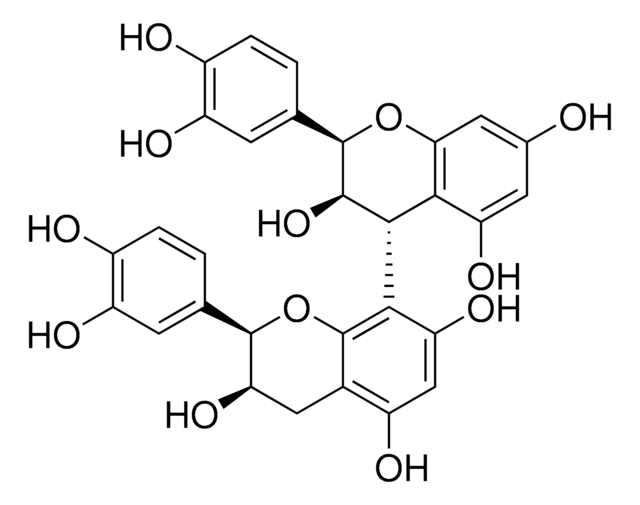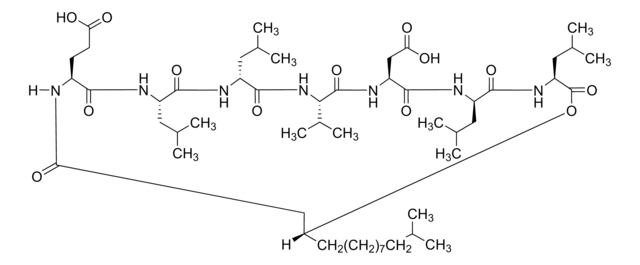C9426
3-[(3-Cholamidopropyl)diméthylammonio]-1-propanesulfonate hydrate
BioReagent, suitable for electrophoresis, ≥98% (HPLC)
Synonyme(s) :
CHAPS
About This Item
Produits recommandés
Description
zwitterionic
Gamme de produits
BioReagent
Essai
≥98% (HPLC)
Forme
powder
Poids mol.
614.88 g/mol (anhydrous basis)
Technique(s)
electrophoresis: suitable
protein quantification: suitable
Impuretés
<0.04% DMF
Pf
157 °C (dec.) (lit.)
Solubilité
water: 50 mg/mL, clear, colorless
Adéquation
suitable for electrophoresis
Température de stockage
room temp
Chaîne SMILES
O.C[C@H](CCC(=O)NCCC[N+](C)(C)CCCS([O-])(=O)=O)[C@H]1CC[C@H]2[C@@H]3[C@H](O)C[C@@H]4C[C@H](O)CC[C@]4(C)[C@H]3C[C@H](O)[C@]12C
InChI
1S/C32H58N2O7S.H2O/c1-21(8-11-29(38)33-14-6-15-34(4,5)16-7-17-42(39,40)41)24-9-10-25-30-26(20-28(37)32(24,25)3)31(2)13-12-23(35)18-22(31)19-27(30)36;/h21-28,30,35-37H,6-20H2,1-5H3,(H-,33,38,39,40,41);1H2/t21-,22+,23-,24-,25+,26+,27-,28+,30+,31+,32-;/m1./s1
Clé InChI
SJCUTFKCLFLIFE-JWTJKVBLSA-N
Vous recherchez des produits similaires ? Visite Guide de comparaison des produits
Description générale
Application
- For membrane permeabilization of cells
- As a component in lysis buffer for homogenization of liver tissues as well as adipose tissue
- As a component in denaturing buffer in enzyme characterization
- As a component of 2D- sample buffer in 2D electrophoresis
- For protein solubilization in isoelectric focusing
Mention d'avertissement
Warning
Mentions de danger
Conseils de prudence
Classification des risques
Acute Tox. 4 Oral
Code de la classe de stockage
11 - Combustible Solids
Classe de danger pour l'eau (WGK)
WGK 3
Point d'éclair (°F)
Not applicable
Point d'éclair (°C)
Not applicable
Listes réglementaires
Les listes réglementaires sont principalement fournies pour les produits chimiques. Seules des informations limitées peuvent être fournies ici pour les produits non chimiques. L'absence d'indication signifie qu'aucun des composants n'est répertorié. Il incombe à l'utilisateur de s'assurer de l'utilisation sûre et légale du produit.
EU REACH Annex XVII (Restriction List)
Faites votre choix parmi les versions les plus récentes :
Déjà en possession de ce produit ?
Retrouvez la documentation relative aux produits que vous avez récemment achetés dans la Bibliothèque de documents.
Les clients ont également consulté
Notre équipe de scientifiques dispose d'une expérience dans tous les secteurs de la recherche, notamment en sciences de la vie, science des matériaux, synthèse chimique, chromatographie, analyse et dans de nombreux autres domaines..
Contacter notre Service technique







